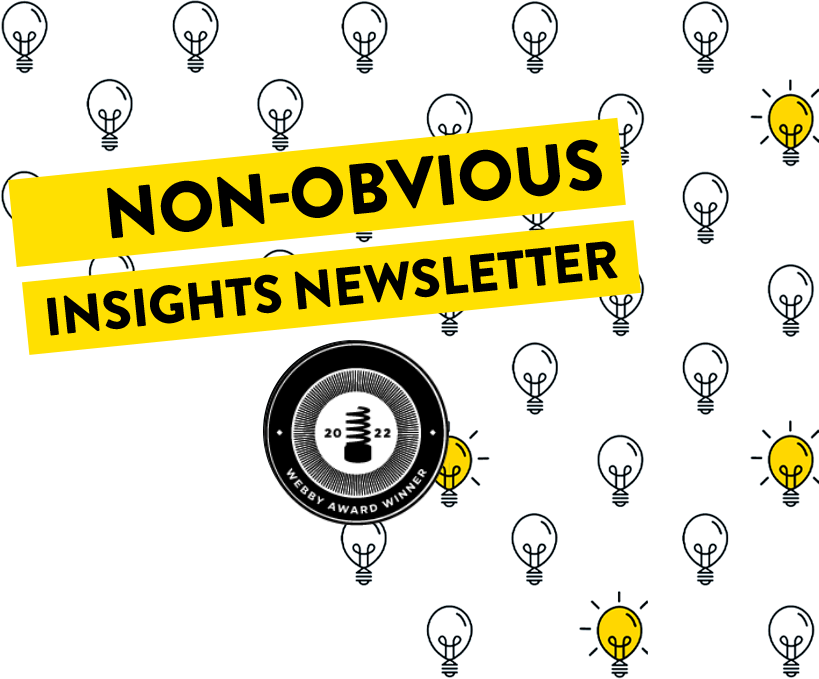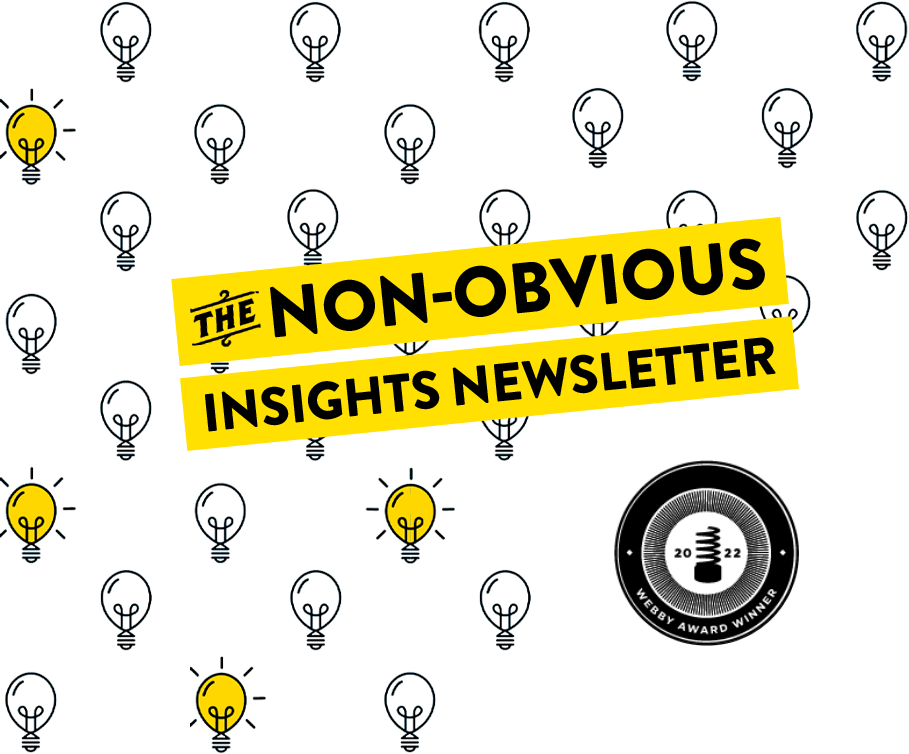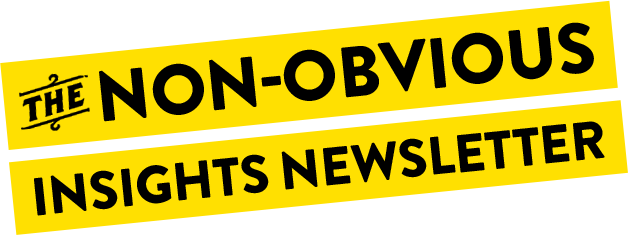Dear Fellow Trend Curator,
Today I’m writing from the only U.S. location to ever have been under eight different flags over the past 450 years. Where am I?
That’s a little bit of trivia to start this week’s newsletter (scroll to the bonus stories section to see the answer). Aside from enjoying a bit of local history, I’ve been curating stories as usual.
This week you’ll read about the real meaning behind the Super Bowl halftime show, why brands are obscuring their logos, who to blame for the deluge of AI slop media online, how losing money the longest became a winning strategy and what Meta’s new effort to protect kids online tells us about the real benefits of government regulation.
Enjoy the stories this week and stay curious!
The Super Bowl Halftime Show Went Over Many People’s Heads. Here’s What It Meant …
Recently it seems like stories about social media often center on the negative impact of various platforms making it easy to spread misinformation, fuel hate or generally inspire an ever-present sense of insecurity about ourselves. This week I was reminded of one of the upsides of social media … the ability to share perspectives worth spreading.
The Super Bowl halftime was a hot topic for online discussion. Most of it centered around whether you “got it” or not. The show had lots of cultural references that would have been easy to miss for much of America. Thankfully, several voices on social media helped to explain exactly what many of us may have missed.
From the powerful backstory behind Kendrick Lamar’s performance to the underlying meaning behind what he didn’t say, to the juxtaposition of all the other voices and stars he included, there was an entire layer of this performance that many of us only discovered the day after the moment. And social media made that happen. It’s good reminder that as much as we may suffer from a feed filled with negativity and rage … there is also the occasional reminder of what some of us used to love about social media in the first place. The chance to read something enlightening that changes the way we see the world around us.
Is This the Age of the Obscured Brand Logo?
There was a longstanding joke among my agency friends about the type of feedback we would often get from corporate clients when presenting our creative work. It essentially boiled down to some version of “make the logo bigger.” Brand managers and CMOs alike have long equated a prominent logo with brand building and, by extension, effective marketing. Lately, there are signs this may be shifting.
Marketing publication The Drum recently reported on brands who are “confidently disguising their logos” in outdoor advertising and they point to recent campaigns from Kellogg’s, Heinz, Tesco and McDonald’s as proof of this trend. It’s no surprise that all these brands are highly recognizable and therefore more readily able to get away with not branding their ads as overtly as lesser-known brands may need to.
Still, it’s an interesting point to consider. How much can or should any of us alter the brand we have in our own advertising and marketing?
I think about this for the brands I own (Non-Obvious and Ideapress) sometimes as well. Neither are household names, but the consistency of branding has always been very important. Should I change it to fit a situation, or keep it consistent no matter what? I’d love to hear your thoughts – hit reply and let me know!
The Secret of Startup Success Might Be Who Is Willing to Lose Money the Longest
Amazon, Spotify, Netflix, Uber … all dominant players in their industry. What if the secret to their success is just that they were all willing to lose money for longer than any of their competitors? An article I read this week suggested that perhaps the ten year journeys of both Netflix and Hulu to now finally become profitable was largely due to their leadership’s willingness to keep losing money until eventually they would make it back. This was famously the strategy behind Jeff Bezos launching the money-losing Prime service which included free shipping for everything in service of building a dominant market share.
Given the number of examples that seem to fit this model, it does present a depressing reality check on how few innovations may survive the wringer of Silicon Valley funding and come out the other side. They say money can’t buy success but based on these examples, that may not entirely be true. The bottom line might really be that anyone can win … as long as there is someone willing to keep writing those blank checks until they do.
Tired of AI Generated Media Slop? Blame Buzzfeed Founder Jonah Peretti …
There’s a category of tech bro that is rapidly emerging within the world of AI. It’s the dudes (and yes, it’s mostly men) who have been touting the upside of AI suddenly changing their tune and worrying about the positive downstream effects of AI on the workplace and greater humanity. This is what you might call “tech brogret”—the same men who championed the most ethically questionable uses for AI are the same ones now decrying what it is doing to our culture and assigning the blame for that on everyone but themselves. They regret what tech is doing, but take no responsibility themselves for this.
Buzzfeed founder Jonah Peretti is a perfect example. Here’s a quote from a recent article on Futurism all about his :
After an embarrassing pivot to AI content, BuzzFeed CEO Jonah Peretti says he’s had enough of all the ragebait, clickbait, and fake news. Peretti, who proudly announced in May 2023 that AI will “replace the majority of static content,” and gloated that its AI-generated content was outperforming its pesky human employees, has seemingly turned another leaf.
Instead of acknowledging his own role in giving up “human agency” and “devaluing labor” — BuzzFeed has lost huge swathes of its workforce over several rounds of layoffs and wiped out most of the company’s stock value over the last four years — Peretti is blaming the tech sector for his failings.
Buzzfeed is a website that has become synonymous with useless clickbaity content. They are one of a handful of media sites that I refused to link to or share stories from. If any of us want a better media ecosystem with stories that aren’t AI generated garbage, here’s an idea: avoid linking to or visiting Buzzfeed. It won’t solve the problem, but it’s not a bad starting point.
What Meta’s Latest Effort to Help Kids Spot Predators Really Tells Us
There is a question that journalists learn to consider often which we should all get better at asking: why now? Any time a story crosses their orbit and they consider writing about it, one of the most fundamental questions they will often start from is trying to understand the timing behind the story. This week Meta announced a “fully fanded” curriculum to teach middle schoolers how to recognize forms of online exploitation, such as sextortion scams and grooming.
This is not a new problem. So why now? One answer is because of the increasing pressure from governments around the world to keep kids off social media entirely. Australia banned it for kids under 16. The U.S. Senate has introduced the “Kids Off Social Media Act.”
That’s the bigger picture that’s easy to miss. Kids are safer online because of online regulations and what that regulation incentivizes companies like Meta to do in response. As President Trump moves rapidly towards deregulation in nearly every sector, this is a story we need to hear more about. Regulation isn’t just red tape and bureaucracy that needs to be fully eliminated. Sometimes it is the only way to create incentives for companies to behave more ethically and actually put people before profits.
The Non-Obvious Media Recommendation of the Week:
The Future of Storytelling Newsletter + Podcast
Several years ago I was invited to an event called the Future of Storytelling. The yearly gathering, hosted by my friend Charlie Melcher, was always an eye-opening look into the work of the most pioneering creators shaping the future of all sorts of experiences. Sadly, Charlie no longer does these annual retreats but he has evolved his community into a group that publishes an amazing monthly newsletter (sign up and read past issues here >>) along with a fascinating podcast and many custom private events.
The newsletter and podcast are my dual picks for the Non-Obvious Featured Media of the Week because of how regularly Charlie and his team manage to curate the best and brightest creators and showcase their latest work along with quick takes on why it matters.
As a side bonus, the FoST team just released a new podcast interview where I join Charlie to talk about the non-obvious future of storytelling. Listen to the episode here >>
The Non-Obvious Book of the Week:
How To Winter by Dr. Kari Leibowitz
February is notorious for being the toughest month of the year for many people. In the Northern hemisphere, these are the cold winter months where social isolation feels at its highest and depression sets in for many people. Whether this describes you these months or not, How to Winter is a book about how to overcome this mindset and find the positivity to lift your mood and “thrive on cold, dark or difficult days.” To write this book, the author Kari Leibowitz traveled around the world to understand how people living in some of the most outwardly depressing places in the world manage to “discover the power of ‘wintertime mindset’— viewing the season as full of opportunity and wonder.” A timely read for a season where many of us aren’t at our best, How to Winter gives you the blueprint to conquer the wintertime blues. For that reason, it’s my pick for the Non-Obvious Book of the Week.
About the Non-Obvious Book Selection of the Week:
Every week I will be featuring a new “non-obvious” book selection worth sharing. Titles featured here may be new or from the backlist, but the date of publication doesn’t really matter. My goal is to elevate great books that perhaps deserve a second look which you might have otherwise missed.
Even More Non-Obvious Stories …
Every week I always curate more stories than I’m able to explore in detail. Instead of skipping those stories, I started to share them in this section so you can skim the headlines and click on any that spark your interest:
- Neil Patrick Harris Launches Engaging New Immersive Story Board Game: Box Two
- How Lego Builds Unique Store Experiences
- Inside the Hunt for Rare Daffodils That Are Feared Lost
- I Dated Multiple AI Partners At Once. Then It Got Weird
- The Trump Supporters Who Didn’t Take Him at His Word
- The Only U.S. Location to Have Been Under 8 Flags[TRIVIA ANSWER!]
How are these stories curated?
Every week I spend hours going through hundreds of stories in order to curate this email. Looking for a speaker to inspire your team to become non-obvious thinkers through a keynote or workshop?
Watch my 2024 speaking reel on YouTube >>
This Non-Obvious Insights Newsletter is curated by Rohit Bhargava.Copyright © 2024 Non-Obvious, All rights reserved





